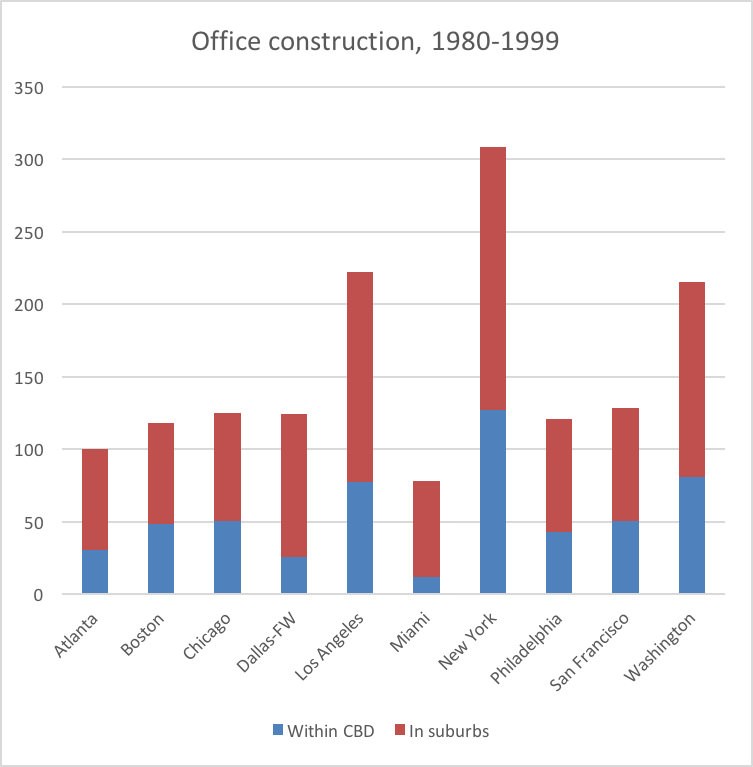DC’s countless thirtysomething office buildings stare down mid-life crises

A view of some of DC's office buildings including the J. Edgar Hoover building, from behind Old Post Office Tower bars. Image by Brian Allen used with permission.
Many cities are well-known for their abundance of one kind of building — think of Miami Beach and its Art Deco hotels, Brooklyn's brownstones, or Los Angeles' mid-century dingbat apartments.
Greater Washington has its own claim to architectural fame: no other region can match our density of 1980s and 1990s office buildings. That’s right: when it comes to ribbon windows, aluminum facade panels, pink marble and brass lobbies, beige carpet, and fluorescent tube lights, we're number one!
The "toilet bowl" in Tysons Corner. Image by Derek Kastner licensed under Creative Commons.
Besides blessing our region with postmodern architectural curiosities such as the “toilet bowl building,” this also means that greater Washington, more so than any other region, faces a challenge now that these buildings are facing mid-life crises. Many require substantial additional investment, as key building systems (like air-conditioning, plumbing, elevators, and roofs) require overhaul or replacement.
At the same time, office tenants have become much choosier. They've dramatically reduced space per employee by almost half in the past decade, and increasingly demand more from their buildings: easy access to transit and restaurants, brighter and more flexible interiors, and plenty of trendy amenities.
This smaller and choosier pool of office tenants means that not every building is going to survive an increasingly competitive marketplace. Already, commercial real estate broker NGKF estimates that up to 22 percent of America's suburban office buildings may be “obsolete”: unsuitable for continued use as offices in their current form. Many of these may not have a future as offices — but complications await.
Many other metro areas, particularly in the Northeast and Midwest, have seen hundreds of older commercial buildings adaptively reused in recent decades. Yet as GGWash editor Dan Reed wrote, “Washington has never had a lot of old industrial space to convert. Instead, it has a lot of office parks like Corporate Drive [in Hyattsville].”
We haven't had as much adaptive reuse, and our building stock faces appreciably different challenges.
Image by Daniel Lobo.
Forget malls, the 80s were really about office parks
Perhaps because these buildings are so architecturally innocuous, it's easy to forget the unprecedented scale of the building boom that took place in the 1980s and continued into the 1990s — largely creating from whole cloth the suburban business clusters then termed “Edge Cities.”
As Tyson Freeman recounts, “The 1980s were dynamic and a lot of fun for many real estate professionals… The development boom in between was the largest in our history: office space doubled to 2.5 billion square feet.; the number of shopping centers rose 57 percent; and hotels surged by 43 percent.”
All of this was made possible by a debt bubble whose spectacular burst caused a national recession in 1990. Freeman continues, “The amount of outstanding debt on commercial properties was close to $250 billion in 1980 and by 1989 had nearly tripled to a staggering $745 billion.”
Yet this construction wasn't evenly distributed across the country. I came across an interesting dataset, in Robert Lang's 2003 book “Edgeless Cities.” Lang is now a professor at UNLV but previously taught at Virginia Tech's Alexandria branch. He compiled statistics from the 1980 and 1999 editions of Black’s Guide, a commercial real estate market data vendor who ceased publication in 2010, and whose appropriate successor is DC-based CoStar Group.
The sheer scale of construction between those years is mind-boggling. Six metro areas built more than 125 million square feet — the equivalent of replicating Chicago's Loop or Lower Manhattan, or enough space to house 500,000 cubicles (at 250 square feet per employee, a common metric at the time.)
Three metro areas (New York, Los Angeles, and Washington) built a million (or more) cubicles apiece — enough to house every single paper-pusher in either metro Boston or Philadelphia. In Washington and Los Angeles, Reaganomics' supply-side tax subsidies were matched by a demand-side boom as defense contractors filled legions of offices and factories.
Yes, even though greater Washington is only the country's sixth-largest metro area, we're number three in terms of the volume of '80s and '90s office buildings — behind metro areas that have two to three times as many residents, and sprawl over much greater expanses.
Chances are, your office was built in this era
Interestingly, by 1999 most regional office markets were dominated by 1980s and 1990s construction — with the sole exceptions of Chicago and New York, historically the giants in the office world. That even holds for such polar opposites as Philadelphia and Dallas, or Boston and Atlanta, which studies have paired as paragons of Frostbelt old urbanism and Sunbelt new suburbanism.
Since Black's Guide stopped updating its databases early in the 2000s, it would be impossible to carry a truly longitudinal comparison forward to the present day, but given the relatively more measured pace of office construction nationwide in the 2000s, it's a good bet that the majority of offices in these markets were still built in the 1980s and 1990s.
Other cities let their downtowns and warehouse districts slowly empty out over decades before they took action and encouraged their adaptive reuse with new uses. Since our region's office building stock is younger, we haven't yet had that problem — and luckily, our region seems to be acting on the opportunity now.
Next: Not every obsolete office building is cut out to become apartments.


